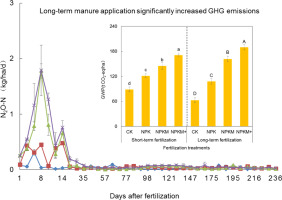Science of the Total Environment ( IF 9.8 ) Pub Date : 2018-03-22 , DOI: 10.1016/j.scitotenv.2018.03.069 Tao Zhang , Hongbin Liu , Jiafa Luo , Hongyuan Wang , Limei Zhai , Yucong Geng , Yitao Zhang , Jungai Li , Qiuliang Lei , Muhammad Amjad Bashir , Shuxia Wu , Stuart Lindsey

|
The impacts of manure application on soil ammonia (NH3) volatilization and greenhouse gas (GHG) emissions are of interest for both agronomic and environmental reasons. However, how the swine manure addition affects greenhouse gas and N emissions in North China Plain wheat fields is still unknown. A long-term fertilization experiment was carried out on a maize-wheat rotation system in Northern China (Zea mays L-Triticum aestivum L.) from 1990 to 2017. The experiment included four treatments: (1) No fertilizer (CK), (2) single application of chemical fertilizers (NPK), (3) NPK plus 22.5 t/ha swine manure (NPKM), (4) NPK plus 33.7 t/ha swine manure (NPKM+). A short-term fertilization experiment was conducted from 2016 to 2017 using the same treatments in a field that had been abandoned for decades. The emissions of NH3 and GHGs were measured during the wheat season from 2016 to 2017. Results showed that after long-term fertilization the wheat yields for NPKM treatment were 7105 kg/ha, which were higher than NPK (3880 kg/ha) and NPKM+ treatments (5518 kg/ha). The wheat yields were similar after short-term fertilization (6098–6887 kg/ha). The NH3-N emission factors (EFamm) for NPKM and NPKM+ treatments (1.1 and 1.1–1.4%, respectively) were lower than NPK treatment (2.2%) in both the long and short-term fertilization treatments. In the long- and short-term experiments the nitrous oxide (N2O) emission factors (EFnit) for NPKM+ treatment were 4.2% and 3.7%, respectively, which were higher than for the NPK treatment (3.5% and 2.5%, respectively) and the NPKM treatment (3.6% and 2.2%, respectively). In addition, under long and short-term fertilization, the greenhouse gas intensities for the NPKM+ treatment were 33.7 and 27.0 kg CO2-eq/kg yield, respectively, which were higher than for the NPKM treatment (22.8 and 21.1 kg CO2-eq/kg yield, respectively). These results imply that excessive swine manure application does not increase yield but increases GHG emissions.


























 京公网安备 11010802027423号
京公网安备 11010802027423号